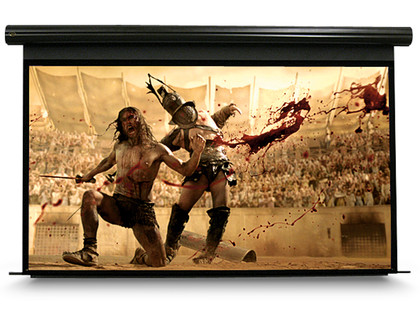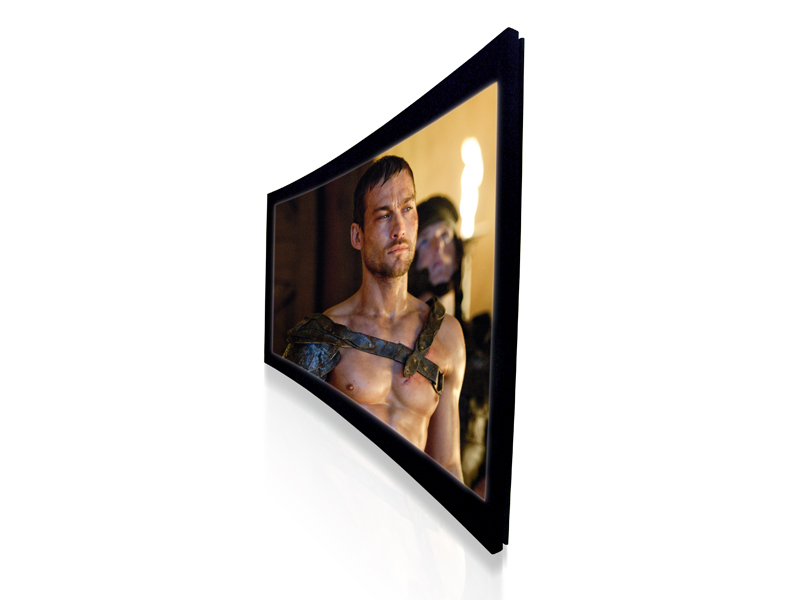TechRadar Verdict
Affordable, brilliantly clear picture and acoustic transparency
Pros
- +
Remarkable screen density for an acoustically transparent screen
- +
Very affordable
Cons
- -
Light reflects onto the bottom of the top casing
Why you can trust TechRadar
Despite being a relatively new name on the UK projection screen scene, Screen Excellence (part of U.See Ltd) has already successfully established itself. This is apparently due to the product that's catching the eye of end users and custom installers alike – the EN4K fabric, as fitted for our test of the motorised RM2-T rig.
This textile is acoustically transparent and so avoids the picture problems often associated with such projection screens (to the extent that it's apparently 4k compatible), while also costing surprisingly little.
The 100-inch RM2-T rig itself looks fairly unassuming, having been designed to be unobtrusive when you're not using it. The container for the screen is just a long, flat-backed barrel in a metallic black finish.
However, this finish immediately raises concern, because it reflects a noticeable strip of light along the barrel's underside when the screen is being used. We're told that the RM2-T will be offered with a full velvet finish as an option, but our test model didn't have this.
Features
After this slightly careless start, things improve fast. The simple motorised mechanism for lowering and raising the screen works surprisingly smoothly and quietly for a unit in the Screen Excellence RM2-T's price bracket. What's more, once it's fully extended, it has enough tension to look as flat and solid as a fixed frame screen.
It's good, too, to see the screen framed by a really light-absorbing black velvet border and fitted with a layer of black backing. This backing plays a crucial role in reducing the light let through (and thus wasted) by the acoustically transparent screen's perforations.
Meanwhile, the weave of the main 0.98 gain, matte white fabric is startlingly dense and smooth for an acoustically transparent screen. And since there's no easily discernible mesh or grid-like pattern in the fabric, no screen structure shows up in the pictures, either.
Sign up for breaking news, reviews, opinion, top tech deals, and more.
On test
Using a trio of projectors – Epson's EH-TW5500, JVC's X3 and Sony's VW90 – with various brightness outputs and source types, the RM2-T never once betrayed a hint of fabric screen structure from any remotely sensible viewing distance.
This is a considerable achievement for an acoustically transparent fabric, which starts at around £1,800 for an 80-inch fixed screen version. Even some similarly priced solid vinyl screens struggle to completely hide their structure from the picture.

Even better, there's not the slightest trace of moiré interference. This wavy line noise can occur with acoustically transparent screens when the rows and columns of pixels in a picture have a step size close to that of the fabric's perforation step or weave size.
The RM2-T's image is totally noise-free and natural, even when showing very bright images.
The fineness and solidity of the EN4K fabric suggests, indeed, that it probably will deliver on its 4k claims. However we couldn't actually test this, given the current difficulties in finding 4k projectors and sources.
What we were able to test on the EN4K, though, was full HD alternate frame 3D footage. The screen resolved Avatar's extraordinary detail levels and perfect depth handling with seemingly effortless accuracy that was just superb.
Three dimensional viewing does highlight a solitary EN4K weakness, as 3D images looked a touch darker and less punchy than they did on our reference solid (not acoustically transparent) screen. The slight loss of brightness created by the screen's acoustic transparency can also lead to colours looking marginally less vibrant, too. But hues are nonetheless accurate in tone and extremely clean with it.
Verdict
While a solid screen might give you a slightly brighter image, by the standards of acoustically transparent fabrics, especially affordable ones, the amount of light seeping through the EN4K material is remarkably small. It's especially small when you consider how well it allows audio to permeate through from speakers mounted behind it.
Screen Excellence claims the projection screen introduces just 2dB of audio loss, despite the density of its fabric. We struggled to detect any deterioration in the audio at all, using our ears and measuring equipment.
At this point, the full and potent appeal of the RM2-T becomes blindingly clear. It balances picture quality and acoustic transparency while costing relatively little. So it makes a hugely attractive proposition for anyone wanting to put together a convenient, but also high-quality, home cinema room without spending a fortune.
Follow TechRadar Reviews on Twitter: http://twitter.com/techradarreview

John has been writing about home entertainment technology for more than two decades - an especially impressive feat considering he still claims to only be 35 years old (yeah, right). In that time he’s reviewed hundreds if not thousands of TVs, projectors and speakers, and spent frankly far too long sitting by himself in a dark room.
